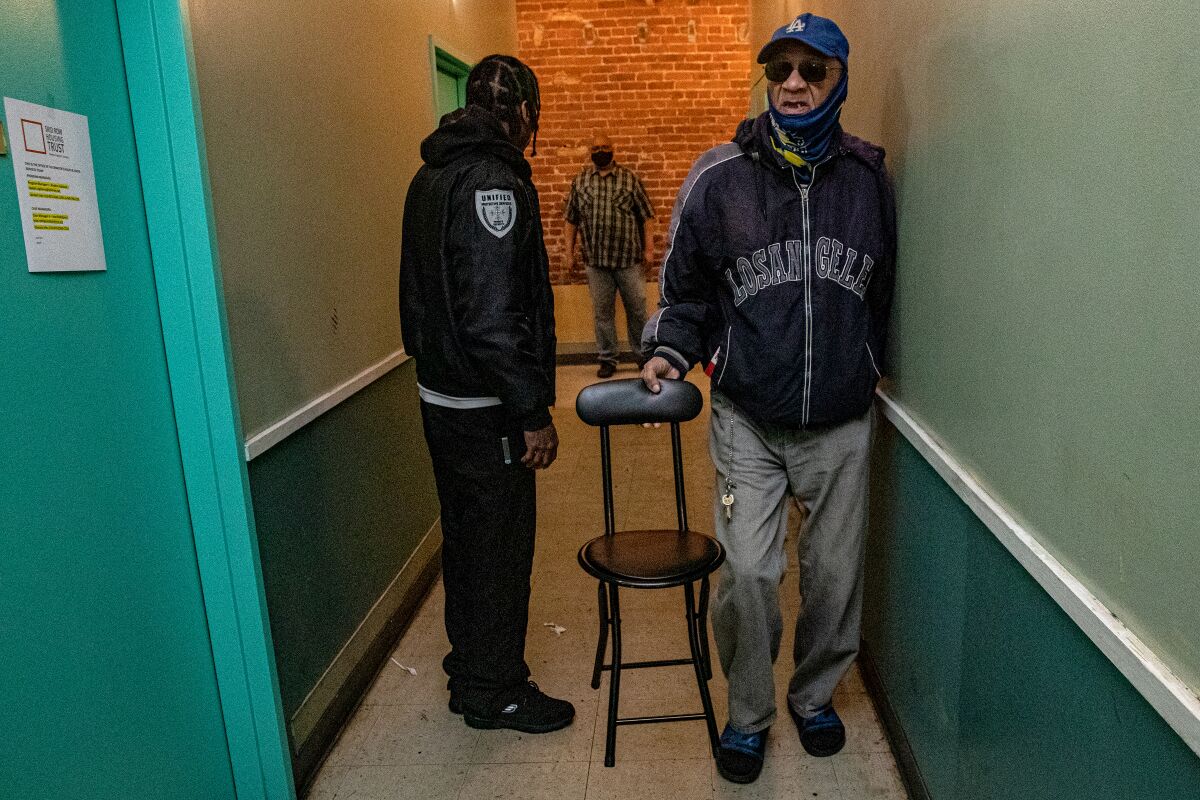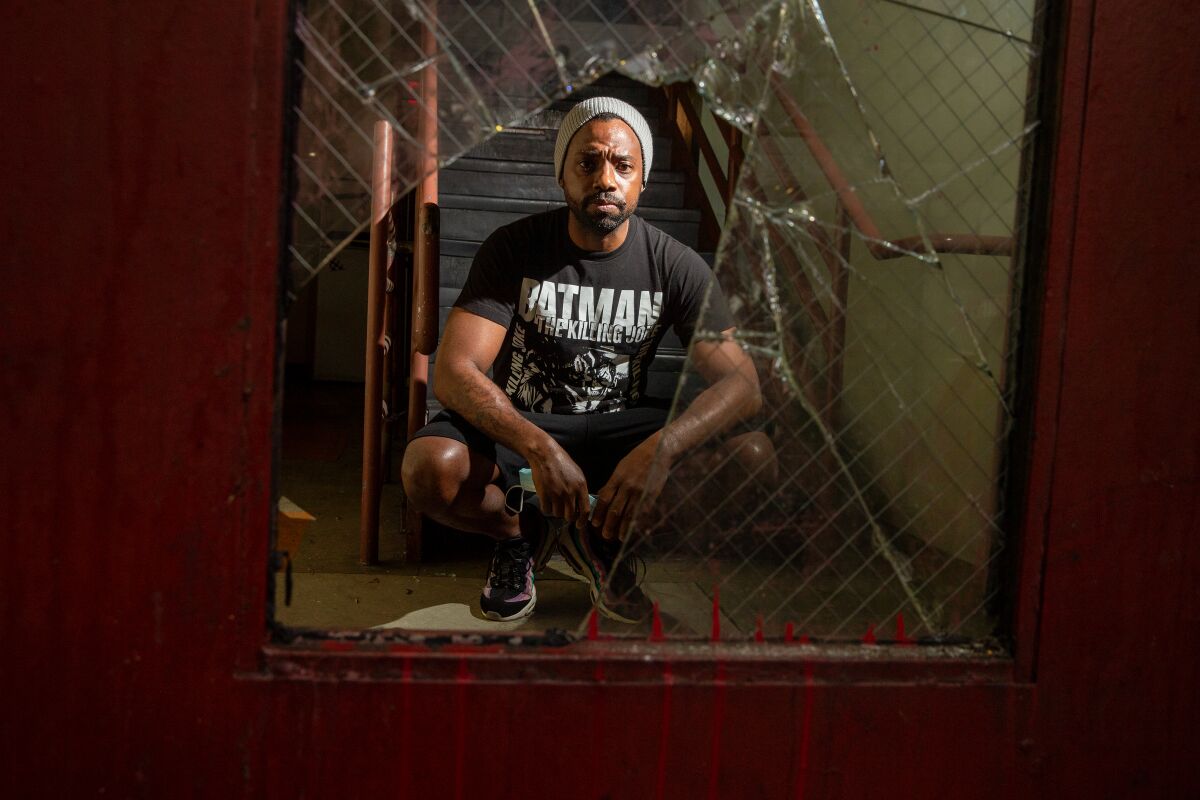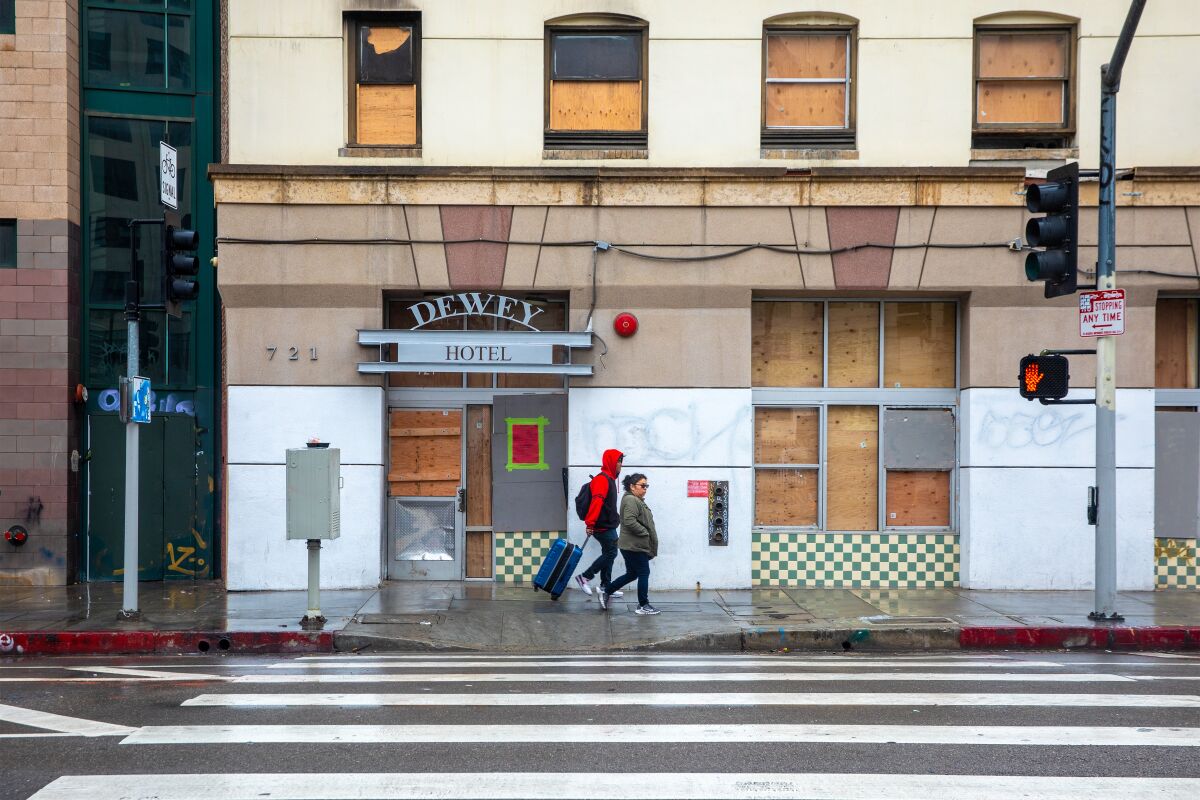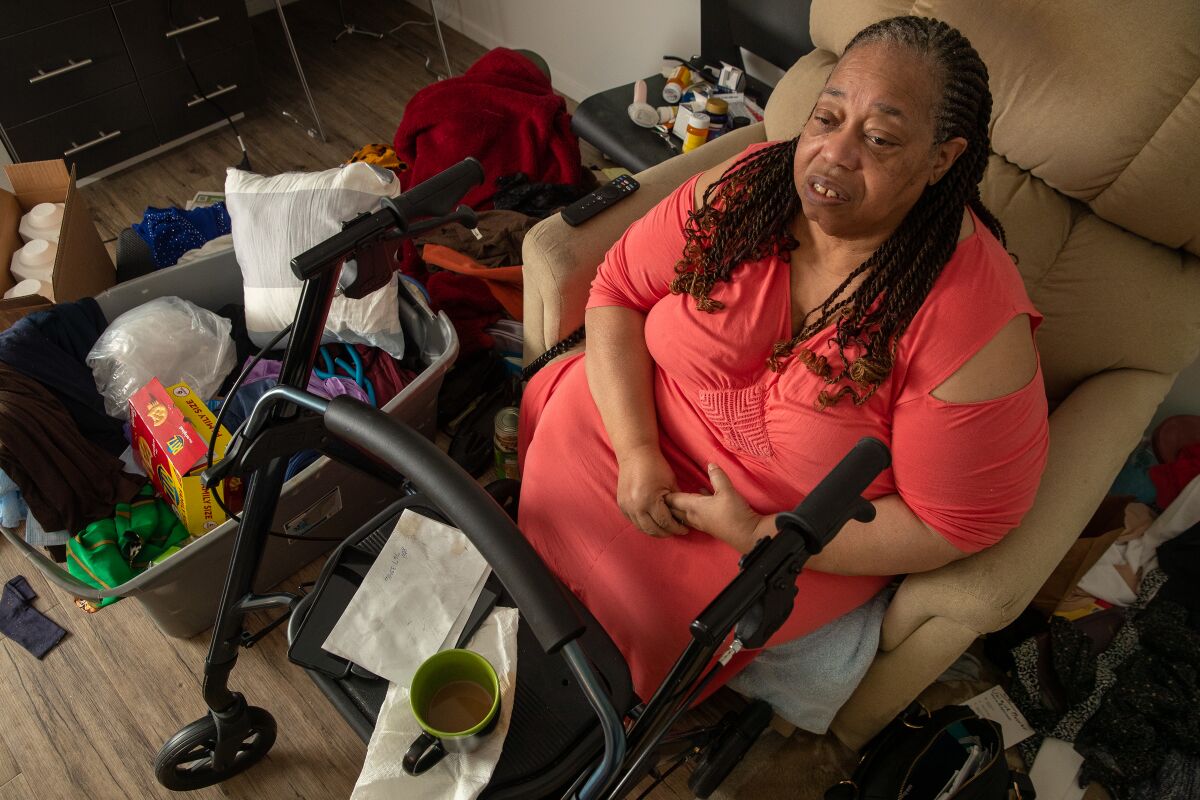The degraded state of the Sanborn Hotel Apartments is apparent from the sidewalk. Holes have been smashed in the wire-reinforced windows of its front doors. And one of the latches doesn’t work, leaving the building open to intruders, who roam the halls at night turning doorknobs, trying to get into open apartments.
Inside, a rancid smell permeates the hallways, begging for Lysol. The manager’s office is dark and empty, as residents say it has been since the latest occupant left last summer. In bathroom No. 2 on the second floor there is no water in the toilet but plenty of human waste.

Longtime tenant James Porter, 75, right, complains about the filthy floors and unsafe environment at the Sanborn Hotel Apartments.
(Irfan Khan / Los Angeles Times)
The Sanborn is one of the 29 buildings owned by Skid Row Housing Trust, a nonprofit that has for more than 30 years been a paragon of homeless housing. But the very model that helped it revive some of downtown’s oldest hotels is now bringing it down.
Earlier this year, leaders of the trust disclosed deepening financial shortfalls that made the upkeep of those buildings impossible. Their solution, guided by the Los Angeles Housing Department, was to turn the entire portfolio over to other housing organizations, a process that at best would take months of difficult negotiations.
Conditions at the Sanborn, observed last week by The Times, show a crisis of far more urgency.
The trust’s interim Chief Executive and Chief of Staff Joanne Cordero said in a statement that she is confident the plan remains feasible.
“We continue to be focused on transitioning our properties to providers who are willing and able to provide ongoing housing and services to our residents,” she said. “We are inspired by our staff who are working tirelessly to keep the properties and services available for those who are most vulnerable in our city. We believe with adequate funding and support from key public and private stakeholders, we can transition the properties successfully.”
But city housing officials acknowledged in an interview that the Sanborn and other trust buildings are in a state of distress that calls for immediate intervention.
Ann Sewill, general manager of the Los Angeles Housing Department, said she will seek City Council authorization to exercise the city’s power as a creditor to take control over at least some of the trust’s buildings and provide security and management as needed.
Sewill said her staff became aware of the emergency while conducting an inventory of the trust’s buildings to document their financial and physical condition for potential future owners.
What they found, Sewill said, suggested the trust was so bereft of cash flow and staff that the day-to-day oversight of its buildings was breaking down, a condition exemplified by the Sanborn.
The only supervision there was a young man standing on the sidewalk outside. He wore a jacket with the emblem of a contract security firm. Residents said he is the janitor and complained that he wasn’t doing his job.

When Jarian Jovan Banks, 44, moved into the Sanborn Hotel Apartments in 2016, he said, “there was a desk clerk. It wasn’t a lot of foot traffic.” But now, “it’s bad to the point where I do not feel safe.”
(Irfan Khan / Los Angeles Times)
Jarian Jovan Banks, who has lived in the building since 2016, said it was different when he moved in.
“There was a desk clerk,” he said. “It wasn’t a lot of foot traffic. You felt safe. Now it’s bad. It’s bad to the point where I do not feel safe.”
Kris Trattner, co-owner of the Nickel Diner next door to the Sanborn, said she has seen a steady escalation of problems since the former manager left.
“I’ve dealt with the riffraff on the street for 14 years so I know how to play that,” she said. “But it’s been elevated in the last six months.”
Trattner said she knew several women who chose to leave the building because they felt unsafe. “Nonresidents are walking up and down the hallways jiggling their doors trying to get in,” she said.
Banks said he got involved in an altercation about a month ago when the fire alarm went off at night. Residents found the kitchen full of smoke and an interloper sitting on a couch in the dark as something on the stove was burning.
“‘Why don’t you just turn the burner off so the fire alarm wouldn’t go off?’” Banks asked. “He doesn’t live there and he doesn’t care.”
Thirteen of the Sanborn’s 41 units have been declared uninhabitable by the Housing Authority of the City of Los Angeles after tenants left.
Residents said they have little contact with case managers and that some tenants cause problems for the others. On the third floor, behind a door wedged open with a roll of toilet paper, a young man stared up from a mattress on the floor, unable to cross his tiny room through a waist-high pile of items, with a bicycle on the top.
The Sanborn, in the 500 block of South Main Street, is one of the trust’s earliest acquisitions and likely its most problematic building. But it’s not the only one in crisis. Tenants of two other buildings have filed lawsuits alleging uninhabitable conditions.
In mid-February, the Dewey Hotel Apartments, two blocks south of the Sanborn, fell under the scrutiny of housing officials after rainwater leaking through its roof caused mold. Then a fire broke out on the second floor. The Housing Authority moved the remaining 22 residents into vacancies in other trust buildings. The Los Angeles Fire Department is investigating the fire as arson.

The Dewey Hotel Apartments, another Skid Row Housing Trust property, is red-tagged and boarded up since mold was discovered and a fire broke out there last month.
(Irfan Khan / Los Angeles Times)
But the Dewey, red-tagged and boarded up, is not entirely unoccupied, housing officials said. Squatters have found a way to get in through the Senator Hotel, another trust building next door.
The Dewey, built in 1911, and the Sanborn, 1908, reflect the challenge of maintaining properties that are both old and antiquated, designed on the early 20th- century hotel model of tiny rooms and common bathrooms and kitchens. The Sanborn was renovated in 1992 using tax-credit financing that involved outside investors with a financial interest in keeping the building shipshape. But those investors exited the project after about 15 years, leaving the trust as the sole owner with long-term loans owed to the city and state.
Twelve of the trust’s 29 buildings fit that category, said Daniel Huynh, assistant general manager of the Housing Department.
Their age, poor condition and lack of equity investors makes them unattractive to the other housing organizations that are being solicited to take over the trust’s portfolio.
In recent years, the trust has expanded its portfolio with new construction that has brought architecturally striking facades to skid row and provided more up-to-date floor plans with individual bathrooms.
PATH, a statewide homeless services provider and housing developer, is one of the organizations evaluating whether it can take on any of the trust’s buildings. Executive Director Jennifer Hark Dietz said PATH is looking at 11 buildings, but only the newer ones that still have equity investors.
Even those new buildings can be troubled by mechanical and human breakdowns.
“We would need to have the capital and operation funds to ensure the building operates at a level of habitability,” Hark Dietz said. “It’s not clear on those sites where the money would come from.”

Yolanda Cunningham Smith, 67, says she is confined to her fifth-floor room at the 649 Lofts, a Skid Row Housing Trust property, for two weeks when the elevators broke down.
(Irfan Khan / Los Angeles Times)
Yolanda Cunningham Smith, a Navy veteran whose arthritis and nerve damage make it difficult for her to get out of her chair, said she was trapped for more than two weeks on the fifth floor of one of the trust’s newer buildings, the 649 Lofts, after the elevator broke down.
The building has a live-in manager, a janitor and uniformed security. But its location in the heart of skid row puts its management under stress.
“At night there is no security,” Smith said.
While stranded in her apartment one night, she said, the fire alarm kept going off. Each time, a strobe light would flash in her room and the PA system would instruct her to evacuate and not use the elevator.
“It was a new building when I moved in,” she said. “I wouldn’t even have imagined this at all,” Smith said, adding that the elevator has broken several times.
After spending 16 days in her room, Smith said Thursday that the elevator had been repaired Wednesday night and she would be able to return to her job as a tax analyst for H&R Block.
Intruders are also common at the 649 Lofts.
“The other day I went to the trash chute,” Smith said. “I opened the door. There was somebody inside the room. They were hitting the pipe.”
- SEO Powered Content & PR Distribution. Get Amplified Today.
- Platoblockchain. Web3 Metaverse Intelligence. Knowledge Amplified. Access Here.
- Source: https://www.latimes.com/california/story/2023-03-17/skid-row-housing-trus-los-angeles-stabilize-buildings



